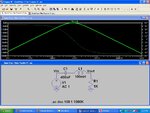uoficowboy
Full Member level 3
- Joined
- Apr 4, 2009
- Messages
- 169
- Helped
- 6
- Reputation
- 12
- Reaction score
- 5
- Trophy points
- 1,298
- Location
- Seattle, Wa, USA
- Activity points
- 2,964
Hi - I was trying to analyze a band pass filter, but the results I'm getting don't make sense to me.
I've attached the simulation.
I first solved for the transfer function of it. It looks like a simple voltage divider - so:
Vout/Vin = R / (R + SL + 1/(SC)) = RSC / (RSC + S^2LC + 1)
So I have a zero at the origin, and poles at (R/(2L)) +/- (1/(2L)) * (R^2 - 4L/C)^0.5. I chose values for R, L, and C so that both the poles are at R/(2L), which in this case is 796Hz.
My understanding is that the zero at the origin gives me +20db/decade starting at w = 1. The two poles at 796 hz should give me -40db/decade starting at 796Hz, before 796Hz it should give me 0db/decade.
But that isn't what I'm seeing. What I'm seeing looks more like I have a zero just before my poles. In fact, the zero at the origin looks a whole lot like the high pass filter that is produced if I short out the inductor (zero at 400Hz).
I just can't seem to figure out what is going on here. My math says one thing but the graph says another.
I've attached the simulation.
I first solved for the transfer function of it. It looks like a simple voltage divider - so:
Vout/Vin = R / (R + SL + 1/(SC)) = RSC / (RSC + S^2LC + 1)
So I have a zero at the origin, and poles at (R/(2L)) +/- (1/(2L)) * (R^2 - 4L/C)^0.5. I chose values for R, L, and C so that both the poles are at R/(2L), which in this case is 796Hz.
My understanding is that the zero at the origin gives me +20db/decade starting at w = 1. The two poles at 796 hz should give me -40db/decade starting at 796Hz, before 796Hz it should give me 0db/decade.
But that isn't what I'm seeing. What I'm seeing looks more like I have a zero just before my poles. In fact, the zero at the origin looks a whole lot like the high pass filter that is produced if I short out the inductor (zero at 400Hz).
I just can't seem to figure out what is going on here. My math says one thing but the graph says another.
